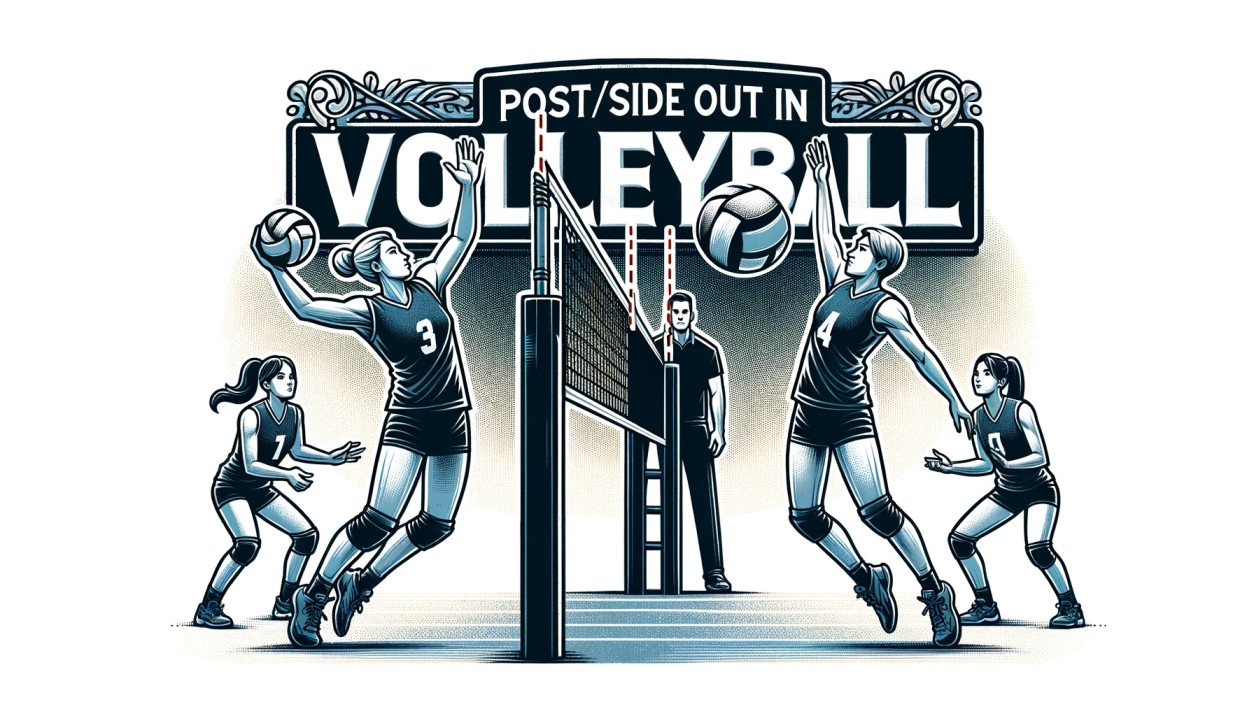Post/Side Out in Volleyball: Complete Guide
Introduction
In this article, complete information about post/side out in volleyball is given. Volleyball, a game of spikes, serves, and strategy, has its own unique language. One term that often mystifies newcomers is “Post/Side Out“.
This isn’t just a term; it’s a pivotal moment in the game. As we delve into this topic, we’ll explore its historical roots and understand its significance in the modern volleyball arena.
Historical Context of Post/Side Out in Volleyball
- Origin of the term and its initial meaning: The term “side out” originally referred to the team on the “side” without the serve. If they won a point, they’d get the serve, but no point was awarded. It was essentially a chance to earn the right to score.
- Evolution of the scoring system: Over the years, volleyball underwent several changes. The most significant was the shift from side-out scoring, where only the serving team could score, to rally scoring, where a point is scored on every serve, regardless of which team served.
Modern Understanding of Post/Side Out
- Definition: In today’s volleyball lexicon, a “side out” is when the receiving team wins the rally, earning the right to serve next. It’s a moment of transition and opportunity.
- Importance in today’s game: Achieving a side out is crucial. It not only provides a chance to score but also disrupts the serving team’s momentum.
- Shift from side-out scoring to rally scoring: Rally scoring has made the game faster and more viewer-friendly. Every rally counts, making each serve, spike, and block even more critical.

The Strategy Behind Achieving a Side Out
- Roles in the team:
- Setters: Often dubbed the quarterbacks of volleyball, they decide which type of attack will be used.
- Spikers: The attackers, aiming to smash the ball past the blockers and defenders.
- Blockers: The first line of defense, trying to stop or redirect spikers’ attacks.
- Importance of communication and teamwork: Volleyball is a game of synchronization. Players need to move in harmony, predict teammates’ actions, and react in split seconds. Effective communication, both verbal and non-verbal, is the key.
- Tactical decisions:
- Playing safe: Sometimes, it’s about keeping the ball in play and waiting for the opponent’s mistake.
- Being aggressive: At other times, it’s about taking risks, going for that powerful spike, or attempting a tricky serve. The choice often depends on the game situation and the team’s strengths.
In the world of volleyball, understanding and mastering the concept of side out is paramount. It’s not just about scoring; it’s about seizing control, dictating the pace, and outsmarting the opponent. As we’ve seen, it’s a term rooted in history but remains as relevant as ever in the modern game.
The Role of Different Positions in Achieving a Side Out
- Setters: The playmakers.
- They orchestrate the team’s offense, deciding who will attack and from where. Their quick decision-making and precise ball handling set the stage for the spikers.
- Spikers: The finishers.
- Armed with power and precision, they aim to finish the play by sending the ball to the opponent’s court. Their ability to read the blockers and find gaps is crucial.
- Blockers: The defenders.
- Towering at the net, they aim to stop or redirect the spiker’s attack. Their timing, positioning, and anticipation can turn defense into offense in an instant.
Common Mistakes Teams Make During Side Out Situations
- Miscommunication among team members:
- A slight misunderstanding can lead to two players going for the same ball or no one going for it at all.
- Poor serve receive:
- A shaky reception can disrupt the entire offensive setup, giving the advantage to the serving team.
- Predictable offensive plays:
- If the setters become too predictable in their choices, the opposing blockers and defenders can easily anticipate and counter the attacks.
FAQs on Post/Side Out
What is the difference between side-out and rally scoring?
Side-out scoring means only the serving team can score. In contrast, rally scoring awards a point to the winning team of each rally, regardless of who served.
Why is achieving a side-out crucial in volleyball?
Achieving a side-out not only gives the team a chance to score but also breaks the rhythm of the serving team, potentially shifting the momentum.
How has the importance of side-out changed over the years?
While the essence remains the same, the introduction of rally scoring has made every side-out opportunity even more valuable, as it’s a chance to both score and defend.
What is sideout in volleyball?
In volleyball, a “sideout” occurs when the team that is receiving the serve wins the point, thereby earning the right to serve next.
What does first ball side out mean?
“First ball side out” refers to the receiving team winning the point on the first serve they receive, without the serving team scoring any points during that rotation.
What is side out scoring in sports?
“Side out scoring” is a system where only the serving team can score points. If the receiving team wins the rally, they earn the right to serve but do not earn a point. This scoring system was formerly used in volleyball before the introduction of rally scoring.
What is the add out in volleyball?
“Add out” is not a standard term in volleyball. It might be a misunderstanding or misinterpretation of another term.
What is a 33 in volleyball?
A “33” in volleyball refers to a quick middle attack where the ball is set about three feet from the setter, typically for the middle hitter to attack.
How many outs are allowed in volleyball?
Unlike sports like baseball, volleyball doesn’t have “outs.” Instead, teams play to a set number of points, and matches are determined by winning a specific number of sets.
Why is it called Sideout?
The term “sideout” originates from the idea that the team on the “side” without the serve would earn the right to serve (and potentially score) by winning a rally.
What is the meaning of sideout?
“Sideout” means that the receiving team has won the rally and earned the right to serve in the next play.
What is 6 pack in volleyball?
A “6 pack” in volleyball slang refers to when a player gets hit in the face or head by a spiked ball.
How do you score 5 a side goals?
In 5-a-side football (or soccer), goals are scored when the ball crosses the goal line between the goalposts and beneath the crossbar, similar to regular football. The team with the most goals at the end of the match wins.
What is the highest scoring sport?
Sports like basketball tend to have high scores due to the nature of the game where multiple points can be scored in quick succession. However, the “highest scoring” can vary based on the level of play and specific games.
What sport has the lowest score wins?
Golf is a sport where the player with the lowest score wins. The objective is to complete the course in the fewest number of strokes.
What do people mean when they say sideout in volleyball, today?
Sideout in Volleyball: In traditional volleyball terminology, a “sideout” referred to when the receiving team successfully won the rally, preventing the serving team from scoring a point, and thus earning the right to serve. In the original sideout scoring system, only the serving team had the chance to score. If the receiving team won the rally, they would get the serve but not a point. This term is still used today, but its meaning has evolved somewhat due to changes in scoring methods.
What’s rally scoring in volleyball, again?
Rally scoring is a method where a point is scored on every serve, regardless of which team served. This is in contrast to the traditional sideout scoring system where only the serving team could score. Rally scoring tends to make games faster and more intense since every rally results in a point for one of the teams. Most modern volleyball competitions, including the Olympics and professional leagues, use rally scoring.
Is it easier to score in sideout or while serving?
This can depend on the level of play and the specific teams involved. Historically, in the sideout scoring system, the advantage was often with the serving team since they were the only ones who could score. However, with the introduction of rally scoring, the dynamics changed a bit.
Conclusion and Final Thoughts
The art of side out in volleyball is timeless. It’s a dance of strategy, skill, and teamwork. For players, it’s a call to constantly evolve, adapt, and perfect this crucial aspect. After all, in the fast-paced world of volleyball, mastering the side out can be the difference between victory and defeat.






